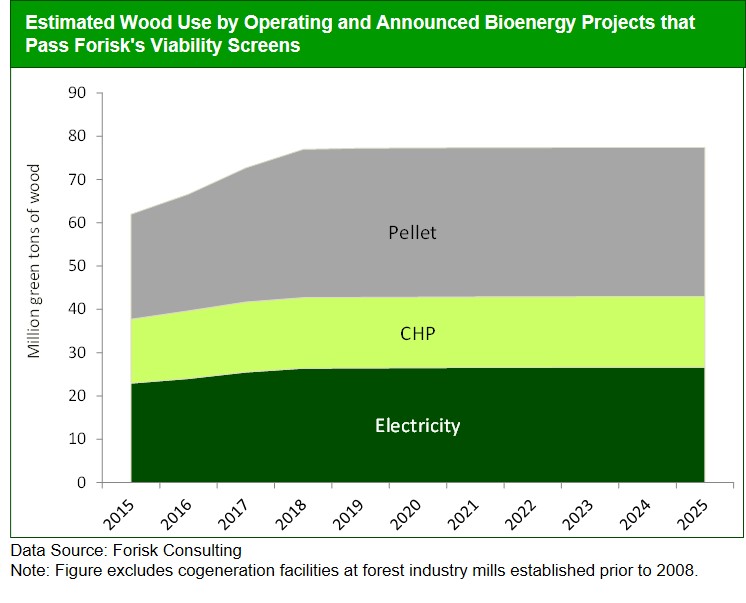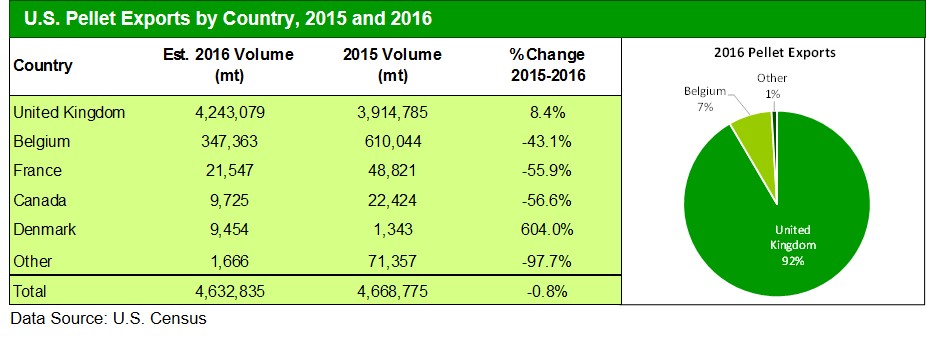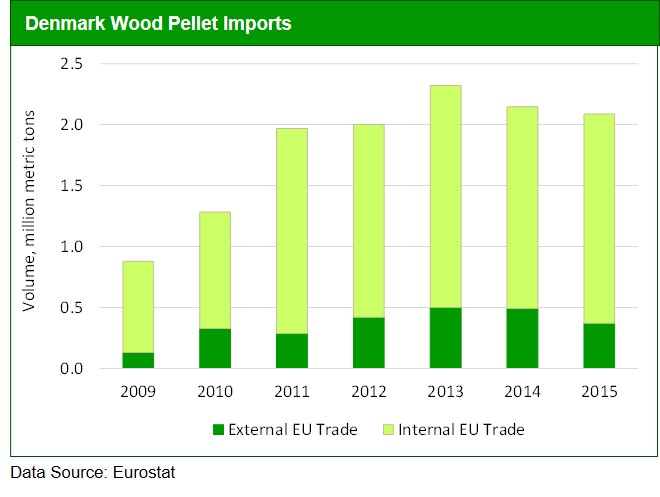This post includes an excerpt from the bioenergy research authored by Amanda Lang and Andrew Copley published in the Q4 2016 Forisk Research Quarterly (FRQ) Publication.
Forisk analysis suggests wood use for viable bioenergy projects in the U.S. will be 79.4 million tons per year by 2025.
As of October 22, 2016, Forisk’s wood bioenergy database tracks 437 operating and announced projects, up from 434 projects in July 2016. These projects represent potential wood use of 117.5 million tons per year by 2025. Based on Forisk analysis, 291 projects pass basic viability screening associated with technology and project development milestones, indicating potential wood use of 79.4 million tons per year. This is up 2.1% from the July 2016 estimate. The figure below details estimated wood use by bioenergy projects in the United States that pass our screens through 2025.

Through August 2016, U.S. wood pellet exports are up 7.7% relative to 2015 volumes, but we project 2016 U.S. wood pellet exports to remain at or near 2015 levels.
The U.S. exported 3.1 million metric tons of wood pellets through the first eight months of 2016. The market share of exported U.S. wood pellets, however, continues to consolidate. The United Kingdom imported 91.6%, over 2.8 million metric tons, of all U.S. wood pellet exports in 2016. Belgium, the second largest U.S. importer in 2016, imported 7.5% of U.S. wood pellets. These two countries alone accounted for 99.1% of all U.S. wood pellet exports in 2016.

Despite increased export volumes to date, we project 2016 U.S. wood pellet exports to remain at or near 2015 levels. Increases in wood pellet exports to the UK are being offset by lower exports elsewhere. Additionally, UK demand increased in H2 2015 when Drax Unit 1 began enhanced co-firing, but has stabilized in 2016. Declines from the closure of E.ON Ironbridge in November 2015, which had converted from coal to 100% biomass, and Drax’s extended maintenance downtime on two of the three wood pellet units mitigated increases from 2015.
International power plant conversions from coal to biomass continue. In Denmark, Dong Energy is converting two combined heat and power (CHP) plants to burn wood pellets. Studstrup Unit 3, a 350 MW CHP, began using wood pellets in 4Q 2016. The 215 MW CHP Avedore Unit 1 plant is also expected to convert to using wood pellets by the end of the year.
Despite being the world’s second largest importer of wood pellets in 2015, importing 2.1 million metric tons, the Danish have not historically sourced imported wood pellets from the U.S. Instead, most of Denmark’s wood pellet imports are sourced from countries within the EU, accounting for 82% of the wood pellet imports in 2015. The U.S. provided just over 1% of the total market share in 2015. This may change, however, given the magnitude of the Danish plants coming on-line and the available wood pellet export capacity in the U.S. South from the large creditworthy companies.

The second SDE+ auction of 2016—a CFD type scheme used to subsidize green energy in the Netherlands—took place in the third quarter with €5 billion to allocate. Results of the auction will be released in the coming months. This follows a July auction in which the Netherlands awarded two biomass companies over €1.5 billion to co-fire wood pellets with coal: RWE received €1.2 billion and Engie received €296 million. Despite these subsidies, projects remain uncertain as the Dutch government is simultaneously planning to phase out coal-fired power stations. Depending on this planned phase-out, U.S. industrial wood pellet demand from Dutch co-firing may fail to materialize. In 2015, the Netherlands only imported 131 thousand metric tons of wood pellets, a decline of 87% from over one million metric tons in 2012. U.S. wood pellets accounted for 62% of all imported wood pellets into the Netherlands in 2012.

To download the most recent Wood Bioenergy Summary, click here.

Leave a Reply